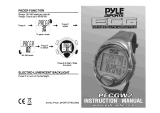3M 1724LSE LEAP™ LSE Finish Blocking Optical RX Lens Processing Pads Operating instructions
- Type
- Operating instructions
This manual is also suitable for
- 1712LSE LEAP™ LSE Finish Blocking Optical RX Lens Processing Pads
- 1725LSE LEAP™ LSE Finish Blocking Optical RX Lens Processing Pads
- LEAP™ LSE 18mm Oval Finish Blocking Optical RX Lens Processing Pads, 1707, 1000 PADS/ROLL
- LEAP™ LSE 24mm Round Finish Blocking Optical RX Lens Processing Pads, 1708, 1000 PADS/ROLL
3M 1724LSE LEAP™ LSE Finish Blocking Optical RX Lens Processing Pads are designed to improve the edging of hydrophobic-coated lenses. These pads are made of a specially formulated adhesive that adheres to hydrophobic coatings while maintaining axis stability.
The 3M 1724LSE LEAP™ LSE Finish Blocking Optical RX Lens Processing Pads can be used with both polycarbonate and high minus lenses. They are also compatible with both cribbing and final edging processes.
To use the 3M 1724LSE LEAP™ LSE Finish Blocking Optical RX Lens Processing Pads, first clean the front surface of the lens with reagent grade isopropyl alcohol. This will remove any loosely bonded hydrophobic coating and ensure that the pad adheres to a stable surface.
3M 1724LSE LEAP™ LSE Finish Blocking Optical RX Lens Processing Pads are designed to improve the edging of hydrophobic-coated lenses. These pads are made of a specially formulated adhesive that adheres to hydrophobic coatings while maintaining axis stability.
The 3M 1724LSE LEAP™ LSE Finish Blocking Optical RX Lens Processing Pads can be used with both polycarbonate and high minus lenses. They are also compatible with both cribbing and final edging processes.
To use the 3M 1724LSE LEAP™ LSE Finish Blocking Optical RX Lens Processing Pads, first clean the front surface of the lens with reagent grade isopropyl alcohol. This will remove any loosely bonded hydrophobic coating and ensure that the pad adheres to a stable surface.


-
 1
1
-
 2
2
3M 1724LSE LEAP™ LSE Finish Blocking Optical RX Lens Processing Pads Operating instructions
- Type
- Operating instructions
- This manual is also suitable for
-
- 1712LSE LEAP™ LSE Finish Blocking Optical RX Lens Processing Pads
- 1725LSE LEAP™ LSE Finish Blocking Optical RX Lens Processing Pads
- LEAP™ LSE 18mm Oval Finish Blocking Optical RX Lens Processing Pads, 1707, 1000 PADS/ROLL
- LEAP™ LSE 24mm Round Finish Blocking Optical RX Lens Processing Pads, 1708, 1000 PADS/ROLL
3M 1724LSE LEAP™ LSE Finish Blocking Optical RX Lens Processing Pads are designed to improve the edging of hydrophobic-coated lenses. These pads are made of a specially formulated adhesive that adheres to hydrophobic coatings while maintaining axis stability.
The 3M 1724LSE LEAP™ LSE Finish Blocking Optical RX Lens Processing Pads can be used with both polycarbonate and high minus lenses. They are also compatible with both cribbing and final edging processes.
To use the 3M 1724LSE LEAP™ LSE Finish Blocking Optical RX Lens Processing Pads, first clean the front surface of the lens with reagent grade isopropyl alcohol. This will remove any loosely bonded hydrophobic coating and ensure that the pad adheres to a stable surface.
Ask a question and I''ll find the answer in the document
Finding information in a document is now easier with AI
Related papers
-
3M Anti-Slip Optical RX Lens Processing Discs, 1705, 100 DISCS/BAG 5 BAGS PER BOX Operating instructions
-
3M Flame Resistant Loop Fastener SJ3518FR Datasheet
-
3M Dual Lock™ Reclosable Fastener TB3561/TB3562 User guide
-
3M Acrylic Foam Tape RT8012US, Gray, 1.2 mm User guide
-
3M Repulpable Flying Splice Tape 906W Template
Other documents
-
AJA KONA LS/LSe User manual
-
Eiki EZ-100 User manual
-
 PYLE Audio PE-CGW2 User guide
PYLE Audio PE-CGW2 User guide
-
Whirlpool ADN 226 User guide
-
George Foreman BRAIN STORM TURBO GFSB1 Owner's manual
-
AJA KONA 3 Installation and Operation Guide
-
LG LSES302ST Installation guide
-
GE EMO3000HWW05 Owner's manual
-
JAI AD-130GE User manual
-
Hotpoint RVM1535MM2SA Owner's manual


